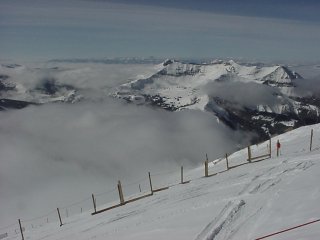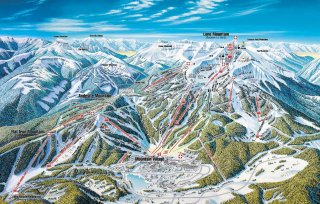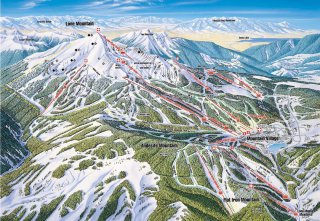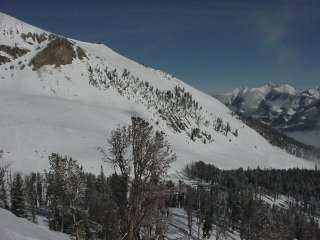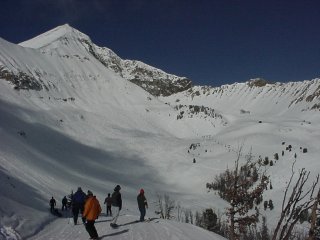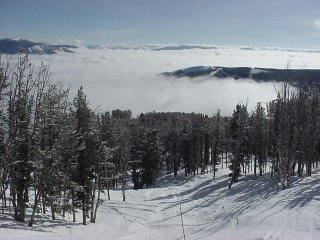Big Sky, MT – Energy buzzed through the growing line
of skiers and snowboarders lined up at the entrance to the Lone Peak tram.
For once, we’d been in the right place at the right time: upon arrival at
the unloading station of the Lone Peak triple chair, when queried, the liftie
informed us that the tram was due to start ferrying passengers at 10:00 a.m.
A quick check showed 9:50 on the clock, so we buzzed down to the tram entrance
and stood in line.
n
The tram had been closed the previous day due to hard and fast
conditions, the result of a mid-March thaw and refreeze cycle. Big Couloir,
the signature route from Lone Peak’s summit, remained closed, but the broad
south-facing expanses of the mountaintop were deemed to be skiable, topped
by a couple of inches of snow that fell overnight.
|
(photo Marc Guido)
|
The Lone Peak tram is a lift unique in North America. Built
in 1995 at a startling cost of $4 million, the tram sports deep anchors
set into the permanent ice that starts less than ten feet below the bedrock
to keep the bottom station from literally moving under the strain of the cables.
In fact, a supplemental refrigeration system has been installed underground
to keep the ice frozen, should it start to melt. All of the heavy machinery
used to build the tram had to be disassembled in the parking lot, flown into
place, and reassembled on site. The tram rises 1,450 vertical feet over its
2,828-foot length, without a single tower to suspend the cables. It takes
only three minutes of ride time to reach the Lone Peak tram’s 11,150-foot
summit.
The group standing in line was a happy bunch. Strangers conversed,
sharing both common love and desire. Despite the limited capacity of the
tram (15 people per run), we managed to squeeze into the first cabin ascending
the nearly vertical rock face of Lone Mountain to arrive at the top station.
Both the tram operator and ski patrol warned about conditions that, while
sufficient to open the terrain, were still hard and fast.
We walked across the gangway to the snow, and climbed the sixteen
additional feet of elevation to Lone Mountain’s true summit. A narrow point,
the views spanned in all directions, and early-morning fog filled the valleys
below. Ski terrain at the ultra-exclusive Yellowstone Club poked through
the cloud cover immediately to our south, and the Tobacco Root Mountains decorated
the horizon stretching off to the north. It was here that Montana’s moniker
“Big Sky Country” best lived up to its name.
The Lone Peak tram is hardly a “lap lift,” as all runs except
for Big Couloir and The Gullies require a succession of three lifts to return
to the summit. Future development plans include a lift on the South Face
near Liberty Bowl, to both open up new terrain and also to easily allow repeat
runs in this neighborhood. This day, however, it didn’t matter, as the refrozen
ruts beneath the dusting of new snow created a bone-rattling and exhausting
experience. The run seemingly continued on forever, and one trip through
“dust on crust” was enough for one day.
A RESORT ON THE GROW
Pioneered in 1969 by famed broadcaster Chet Huntley upon his
media retirement, Big Sky Resort is now one of Boyne USA Resorts’ holdings,
along with Boyne Mountain and Boyne Highlands in Michigan, Crystal Mountain
in Washington, Brighton in Utah, and others. Huntley unfortunately never
lived to see his vision take shape, passing away from lung cancer before the
first bullwheel ever turned, and Boyne bought the resort from the original
corporate investors in 1976. The resort has grown at a blistering pace ever
since, filling the narrow canyon leading to the resort from the Gallatin Valley.
The second homes dotting the landscape increase in frequency as the road snakes
upward, culminating in a veritable town upon one’s arrival at the Mountain
Village.
|
|
It is here in the Village that most lodging opportunities are
centered, capped by the massive Summit at Big Sky, the resort’s newest property
that features a total of 213 condominium units of varying sizes. “A condominium
hotel of epic proportions,” in the resort’s own words. Situated at the epicenter
of Village activity, three high-speed lifts load within 100 yards of this
property comprised of privately-owned units that are managed like a hotel.
The units have unique lock-out capability to subdivide condos into individual
hotel rooms. The Mountain Mall’s retail establishments are a mere spitting
distance away, as is the resort’s previous hallmark lodging establishment,
the Huntley Lodge.
The Shoshone Lodge’s condominium units round out the Village’s
immediate beds, but other properties of every conceivable type span out in
nearly every direction. A tight collection of cookie-cutter cottages dots
the Andesite Mountain hillside immediately above the village, and the flanks
of adjacent hillsides reveal private homes and condominiums. In fact, Big
Sky’s Central Reservations Office offers a menu of no fewer than a dozen separate
properties in or adjacent to the Mountain Village. Many lodging choices are
tied to the trail network via access lifts, such as the Lone Moose Triple,
the White Otter Double, or the Pony Express.
|
|
Big Sky Resort isn’t stopping with the status quo. Presently
in development are the Powder Ridge Cabins, with direct access to the White
Otter chair. While they’re situated only 500 yards away from the Village’s
core plaza area, the cluster orientation and undisturbed woods place these
1,434 square foot units in a very private setting. A new Village Center
is on the drawing board, complete with lockers, a nightclub, meeting rooms,
retail and dining facilities, a destination spa, and privately-owned corporate
hospitality suites. Scheduled to open in December 2001, the Mountain Inn
at Big Sky is under construction at the time of this writing, to be a part
of the Holiday Inn Express reservation system. The facility will offer 90
suites promised to be “mountain-side accommodations at competitive prices.”
A future transfer lift is envisioned to connect the Mountain Inn at Big Sky
to the resort’s lift and trail network. The resort is also offering additional
private mountain homesites.
Other properties being developed by Big Sky’s neighbors, independent
of the resort itself but still connected to the mountain via lifts and trails,
include Lone Moose Meadows, built by Yellowstone Club founder Tim Blixseth,
and Moonlight Basin Ranch, connected via the Pony Express chair.
Did you get the idea that Big Sky Resort is growing quickly?
Good, then we’ve made our point.
In an unfortunate trend mirrored at many Western resorts these
days, Big Sky isn’t as friendly to the day skier as it is to the overnight
guest. No true “day lodge” exists here, and skiers and snowboarders visiting
from other areas are limited to a locker room in the Snowcrest Lodge for setting
up camp. No conventional ski area cafeterias exist here, either, nor are
there indoor areas for brown-baggers to picnic. If you plan to buy lunch
at the mountain, you’re relegated to sit-down service, and some 21 choices
await you in the Mountain Village. A lunch-time hint: if you’re looking for
a more casual experience, skip the Village, and sneak up to the summit of
Andesite Mountain and enjoy a scrumptious barbeque on the deck of the Dug-Out
mountaintop warming hut. Call us traditionalists, call us old-fashioned,
but we still appreciate the camaraderie and simple creature comforts provided
by a day lodge.
For dinner, you might range further afield and off the resort
proper in search of sustenance. Not to be missed is Buck’s T-4 Lodge, on
U.S. Rte. 191 just south of the Big Sky access road. Featuring a selection
of game dishes nearly as extensive as the wine list, Buck’s provides a unique
taste of Montana. The medallions of venison filet mignon braised in a red
wine reduction come highly recommended.
Big Sky heavily promotes its conference facilities, and the
resort accordingly actively courts convention business and corporate meetings.
Ninety percent of Big Sky’s summer revenues are derived from group sales.
Virtually every Mountain Village building possesses meeting and function space,
totaling 46,000 square feet in all, allowing conference guests to travel from
guest rooms to meeting rooms without even venturing outdoors. Yet, when the
meeting schedule permits free time, convention goers are a mere stone’s throw
from access to the resort’s lift and trail network.
Unlike most Montana resorts, Big Sky feels corporate. It feels
developed, planned … dare we say, “calculated?” Big Sky is the hands-down
leader in Montana skier and snowboarder visits, and it shows.
INTERMEDIATE HEAVEN
|
(photo Marc Guido)
Traversing along Jay Walk (photo Marc Guido) |
No matter how you cut it up, Big Sky is … well, “big.” A total
of 18 lifts convey 20,000 riders per hour to 3,600 skiable acres of terrain
entirely on private land. The overall vertical drop of 4,350 feet is the
greatest in the United States. Named runs add up to a total of 85 whopping
miles. While skier visits hover around a healthy 300,000 annually, spread
them out across that much terrain and you’ve still got lots of elbow room.
Big Sky’s terrain is roughly divided between two mountains,
11,166-foot Lone Mountain and 8,800-foot Andesite Mountain. A third summit,
8,092-foot Flat Iron Mountain, is really just a lower elevation on Andesite.
The Lone Peak tram and Challenger lifts carry guests to Big Sky’s most prominent
advanced terrain, but with the exception of some lesser-known shots from the
Thunder Wolf High-Speed Quad low on Andesite, there is surprisingly little
at Big Sky to truly challenge experts. On paper, the total advanced acreage
at Big Sky is significant, but when one considers the number of options presented
by these choices, the perceived amount of truly expert terrain shrinks considerably.
Notable highlights in addition to anything off of the Lone Peak tram include
Nashville Bowl and Midnight, rendered even more challenging when limited visibility
inspires vertigo, and tight unmarked trees between the Swift Current Express
and Gondola One. The latter’s unique topography allows one to traverse to
skier’s right at the end of each shot, revealing yet another short fall line
descent before repeating the process ad nauseum. Experts should not overlook
Rock Pocket and Snake Pit, a pair of precipitous tree shots culminating in
a series of rock ledges that narrow down the skiable line into a tight hourglass.
In warm times such as those experienced during our mid-March
visit, Big Sky may frustrate experts somewhat in that very little of the terrain
boasts a northerly exposure. Lone Mountain’s terrain primarily faces east,
and many of the larger faces angle east-southeast. The appropriately-named
South Face, the largest component of the terrain accessible via the Lone Peak
tram, possesses the usual drawbacks inherent to any slopes that receive all-day
sun. Nashville Bowl, a small cleft to climber’s right of the Swift Current
Express, the Ramcharger face of Andesite Mountain and some lines lower down
toward Flat Iron Mountain are all that truly face due north.
There may be lots of the color black on Big Sky’s trail map
(43% of all marked runs), but the resort is truly intermediate heaven. Miles
and miles of animated groomers spill off in every direction, from broad boulevards
like Calamity Jane and Crazy Horse, to narrow shots beneath the resort’s gondola.
Wide-open fields like Elk Park Meadows will delight intermediates for literally
hours, and many will enjoy the opportunity to travel from one end of this
massive 3,600-acre resort to the other. Blue-square terrain here has character
– with dips, rolls and other natural terrain undulations, the cruisers of
all types peak high on the fun meter. Those who need greater dips and rolls
than nature can provide will appreciate the immense terrain park on Andesite,
and a second series of terrain features alongside Crazy Horse on Lone Mountain.
It is for intermediates that Big Sky’s terrain truly shines. Intermediates
are also most likely to appreciate the creature comforts that Big Sky’s Mountain
Village delivers.
Novices have the broad, gentle rolls of the slopes beneath the
Explorer lift to call their own. With the exception of some advanced skiers
and riders speeding through as they travel back from Challenger, the Explorer
chair is somewhat separated from the remainder of Lone Mountain’s terrain.
Once a beginner’s skills progress a bit, they may access the Explorer terrain
from above via the resort’s gondola, or even from the Swift Current Express
high-speed quad via Jay Walk, a narrow cat track that leads guests to the
lifts that carry them above the tree line. Novices will also find broad expanses
of green terrain accessed by the Southern Comfort lift on Andesite’s back
side.
ALTERNATIVES, ALTERNATIVES …
|
|
Intermediates and above have at their fingertips Montana
Backcountry Adventures, running backcountry snowcat ski and snowboard
tours on private Moonlight Basin Ranch land on Lone Mountain’s back side.
Steep and deep trees, open bowls, and a variety of runs are all well-represented.
Bridger Bowl,
Grand Targhee,
and Jackson Hole are all
within daytrip range of Big Sky.
Non-skiers may not find the boutique selection of, say, Vail
or Breckenridge, but adventurous types will find ample diversions at Big Sky.
Take in a massage or aromatherapy at the Solace Spa, relax in the outdoor
pool and hot tub, enjoy a sleigh ride dinner at Lone Mountain Ranch, snowshoe,
go dog sledding with Spirit of the North, fly
fish on one of five blue-ribbon trout streams with Gallatin
Riverguides, go horseback riding, or even hop on the daily transportation
to nearby Yellowstone National Park, where you can charter snowcoach
tours or snowmobiles. An IMAX
theater is also located in West Yellowstone. Montana
Backcountry Adventures offers a snowcat ride to their backcountry dining
lodge for a casually elegant meal overlooking Moonlight Basin Ranch. Those
with cars can send their loved ones into Bozeman for the day to take in the
world-renowned dinosaur collection at the Museum of the Rockies, or view the
work of regional artists at the Emerson Cultural Center. You might also
ski or ride the steeps at Bridger
Bowl while they’re in Bozeman.
GETTING THERE
It’s tough to beat Big Sky for ease of access. One hundred
and fifty weekly flights are available into Bozeman’s convenient Gallatin
field, only 45 minutes north of the resort with no mountain passes to cross,
aboard Northwest, Delta, Horizon Air and Sky West. Northwest Airlines
was one of Big Sky Resort’s initial investors, and accordingly offers the
most diverse selection of flights. The airport is situated within the broad
Gallatin Valley, which lacks the challenging mountain approaches facing flights
arriving at some other western ski destinations. Shuttles are available
at the airport, as are motor coach charters for large groups. If you prefer,
several national car rental agencies are located at the airport, although
the wintertime Snow Express shuttle bus operates on a fixed route between
condominiums, hotels, restaurants and activities, rendering a rental car at
the resort itself unnecessary. If you’re driving, I-90 passes right
through Bozeman, so only the last 45 minutes of your trip are along two-lane
road, southward into the Gallatin Canyon.


